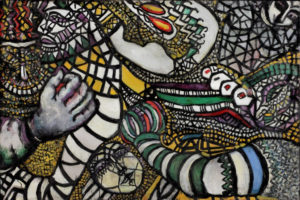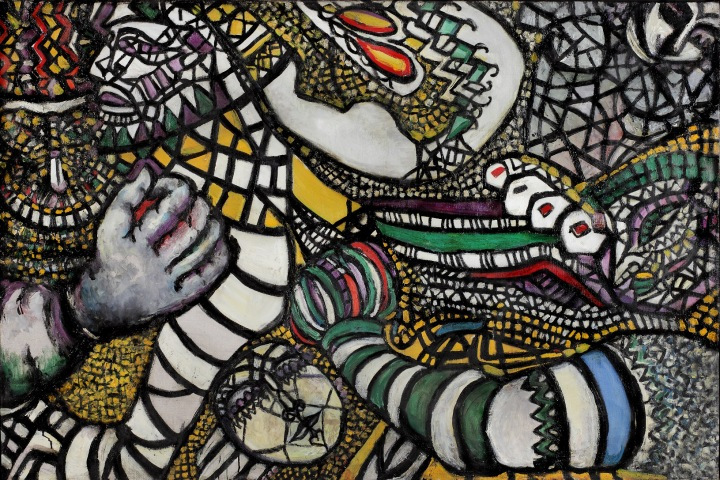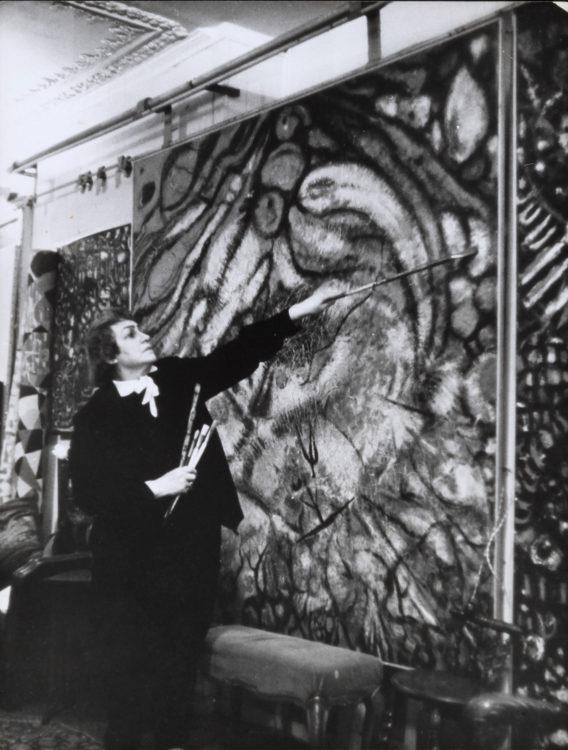Review
Fahrelnissa Zeid, Fight against Abstraction, 1947, oil paint on canvas, 101 x 151 cm, Istanbul Modern Collection/ Eczacibaşi Group Donation, © Raad Zeid Al-Hussein © Istanbul Museum of Modern Art
After Meschac Gaba in 2013 and Bhupen Khakhar in 2016, the exhibition dedicated to the work of Fahrelnissa Zeid is the third resulting from the partnership between Tate Modern and the Deutsche Bank Kunsthalle, the aim being to highlight artists of African or Asian origin. The painter and sculptress Fahrelnissa Zeid (1901–1991) was born in Büyükada, near Istanbul, Turkey, and lived in Berlin, Baghdad, London and Paris before settling in Amman in Jordan. Speaking Turkish, French and English perfectly, this artist is representative of the cosmopolitanism of the Middle East in the 20th century.

Fahrelnissa Zeid in her studio, Paris, c. 1950s, Raad Zeid Al-Hussein Collection, © Raad Zeid Al-Hussein
Her work is a challenge to our current, often compartmentalised understanding as it arises from a cultural palimpsest and personal synthesis.1 She claimed not to be attached to any artistic current, though she exhibited with the group “D” during the 1940s, important to the definition of Turkish modernity, and was considered an eminent member of the post-war Nouvelle École de Paris. Although her art evades classification, her biography was decisive to her artistic development. Her indisputably novelistic life included two marriages, widespread travel (Venice, Munich, Budapest, Scotland, among other destinations), depression followed by a suicide attempt, good and bad fortune, social advancement and relegation.

Fahrelnissa Zeid, Break of the Atom and Vegetal Life, 1962, Z. Yildirim Family Collection, © Raad Zeid Al-Hussein

Fahrelnissa Zeid, Fight against Abstraction, 1947, oil paint on canvas, 101 x 151 cm, Istanbul Modern Collection/ Eczacibaşi Group Donation, © Raad Zeid Al-Hussein © Istanbul Museum of Modern Art
Kerryn Greenberg, the exhibition curator, has chosen to present the works in chronological order so as to better clarify the relationships between historic influence, personal experience and artistic expression. The five rooms of works reflect five periods related to art history: the first is dedicated to the artist’s studies and training in Istanbul (at the Fine Arts Academy for Women, then the Fine Arts Academy) and Paris (the académie Ranson, where she studied under Roger Bissière), and reflects the progressive professionalisation of her practice similar to expressionist figuration; the second attests the hesitancy and difficulties she suffered faced by the choice between figuration and abstraction; the third displays her successes in the field of geometric abstraction; the fourth her excursions into the domain of lyrical abstraction; and the fifth her portraiture and sculptural experiments.
Although different in subject and composition, Fahrelnissa Zeid’s works share an intensity due in particular to the brightness of the colours, the manner in which they contrast with the thick, sure black lines, and the energy inherent in the composition whatever the format. The monumental My Hell (1951) is emblematic: two dark spaces occupy the centre of the composition while spreading waves of fractals are in the dominant tones of red and yellow. This kaleidoscopic technique is not unlike Byzantine mosaics and Ottoman stained glass windows. However, Zeid ambitiously linked herself with Maria Helena Vieira da Silva, Serge Poliakoff and Jean Degottex after World War II with the desire of renewing her practice. The most surprising thing about the exhibition is the work Paléokrystalos (1967–69), composed of painted chicken bones set in resin like a collection of domestic fossils. It reflects Fahrelnissa Zeid’s interest in archaeology while also bearing affinities with the accumulation of the young Arman, though imbued with a sense of the tragic and fully removed from Pop. This woman artist’s experimental works lead us as she explores the nuances of her identity, so as to capture the essence of things and the honey of life.
Fahrelnissa Zeid, from 13 June to 8 October 2017, Tate Modern, London, United Kingdom
The catalogue goes more deeply into this subject: Greenberg Kerryn (ed.), Fahrelnissa Zeid, exh. cat., Tate Modern, London (13 June–8 October 2017), London, Tate Publishing, 2017.









